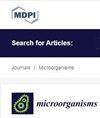水管理引起的根瘤菌圈和大体积土壤微生物群落变化改变了它们对尿素衍生碳的利用率
IF 4.1
2区 生物学
Q2 MICROBIOLOGY
引用次数: 0
摘要
作为农业中最重要的肥料之一,尿素衍生氮(urea-N)在农业生态系统中的去向已被详细记录。然而,人们对尿素衍生碳(urea-C)在土壤生态系统中的功能却知之甚少,尤其是哪些土壤微生物从尿素衍生碳的供应中获益最多,以及根瘤菌层和大体积土壤微生物对尿素衍生碳的利用是否会受到灌溉制度的影响。为此,我们使用 13C 标记的尿素进行了土壤盆栽实验,研究在大水漫灌(FI)和节水灌溉(CI)条件下,根圈和大体积土壤微生物群落组成的变化,以及尿素衍生的 C 被根圈和大体积土壤磷脂脂肪酸(PLFA)池吸收的差异。我们的研究结果表明,根圈和大体积土壤微生物群落的大小和结构受灌溉制度的影响很大。与 FI 处理相比,CI 处理明显增加了根圈和大体积土壤中 PLFA 的总量,但只对大体积土壤中革兰氏阳性菌(G+)的丰度有明显影响。相比之下,灌溉制度引起的微生物群落结构变化在根圈土壤中比在块状土壤中更为明显。与 FI 处理相比,CI 处理显著增加了根圈土壤中 G+ 和放线菌的相对丰度(p < 0.05)。根据 PLFA-SIP 的结果,在两种处理中,大部分标记的尿素衍生 C 被结合到 16:1ω7c、16:0 和 18:1ω7c 中。尽管存在这些总体趋势,但不同处理下 13C 在 PLFA 池中的掺入模式有所不同。单个 PLFA 的因子载荷表明,在不同灌溉制度下,18:1ω7c、16:1ω7c 和 16:1ω5c 相对富含块根土壤中的尿素-C,而 17:1ω8c、i16:0 和 16:0 相对富含根瘤土壤中的尿素-C。载荷还证实,在 CI 处理下,10-me16:0、cy17:0 和 cy19:0 的尿素-C 相对富集,而在 FI 处理下,14:0、a15:0 和 15:0 的尿素-C 相对富集。这些结果不仅有助于揭示土壤中尿素-C的截留机制,而且有助于了解关键微生物在元素循环中的功能。本文章由计算机程序翻译,如有差异,请以英文原文为准。
Water Management-Mediated Changes in the Rhizosphere and Bulk Soil Microbial Communities Alter Their Utilization of Urea-Derived Carbon
As one of the most important fertilizers in agriculture, the fate of urea-derived nitrogen (urea-N) in agricultural ecosystems has been well documented. However, little is known about the function of urea-derived carbon (urea-C) in soil ecosystems, especially which soil microorganisms benefit most from the supply of urea-C and whether the utilization of urea-C by the rhizosphere and bulk soil microorganisms is affected by irrigation regimes. To address this, a soil pot experiment was conducted using 13C-labeled urea to investigate changes in the composition of the rhizosphere and bulk soil microbial communities and differences in the incorporation of urea-derived C into the rhizosphere and bulk soil phospholipid fatty acids (PLFA) pool under flooded irrigation (FI) and water-saving irrigation (CI). Our results suggest that the size and structure of the rhizosphere and bulk soil microbial communities were strongly influenced by the irrigation regime. The CI treatment significantly increased the total amount of PLFA in both the rhizosphere and bulk soil compared to the FI treatment, but it only significantly affected the abundance of Gram-positive bacteria (G+) in the bulk soil. In contrast, shifts in the microbial community structure induced by irrigation regimes were more pronounced in the rhizosphere soil than in the bulk soil. Compared to the FI treatment, the CI treatment significantly increased the relative abundances of the G+ and Actinobacteria in the rhizosphere soil (p < 0.05). According to the PLFA-SIP, most of the labeled urea-derived C was incorporated into 16:1ω7c, 16:0 and 18:1ω7c under both treatments. Despite these general trends, the pattern of 13C incorporation into the PLFA pool differed between the treatments. The factor loadings of individual PLFAs suggested that 18:1ω7c, 16:1ω7c and 16:1ω5c were relatively enriched in urea-C in the bulk soil, while 17:1ω8c, i16:0 and 16:0 were relatively enriched in urea-C in the rhizosphere soil under different irrigation regimes. The loadings also confirmed that 10-me16:0, cy17:0 and cy19:0 were relatively enriched in urea-C under the CI treatment, whereas 14:0, a15:0 and 15:0 were relatively enriched in urea-C under the FI treatment. These results are helpful not only in revealing the interception mechanism of urea-C in soil but also in understanding the functions of key microbes in element cycles.
求助全文
通过发布文献求助,成功后即可免费获取论文全文。
去求助
来源期刊

Microorganisms
Medicine-Microbiology (medical)
CiteScore
7.40
自引率
6.70%
发文量
2168
审稿时长
20.03 days
期刊介绍:
Microorganisms (ISSN 2076-2607) is an international, peer-reviewed open access journal which provides an advanced forum for studies related to prokaryotic and eukaryotic microorganisms, viruses and prions. It publishes reviews, research papers and communications. Our aim is to encourage scientists to publish their experimental and theoretical results in as much detail as possible. There is no restriction on the length of the papers. The full experimental details must be provided so that the results can be reproduced. Electronic files and software regarding the full details of the calculation or experimental procedure, if unable to be published in a normal way, can be deposited as supplementary electronic material.
 求助内容:
求助内容: 应助结果提醒方式:
应助结果提醒方式:


